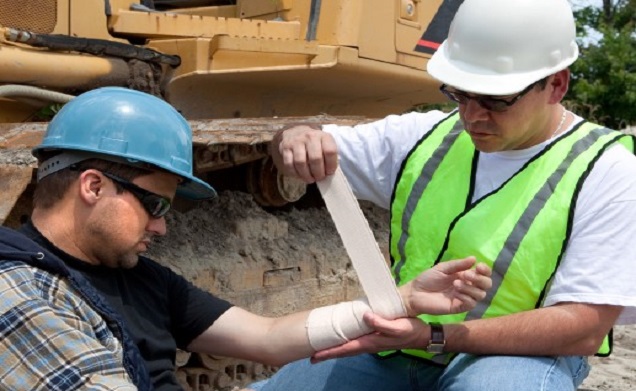A contractor’s work environment must be safe for everyone involved, which means having the proper first aid supplies and personnel in an emergency

This article will discuss some essential tips and strategies for contractors to help them meet their first-aid obligations.
Evaluate Your First Aid Needs
When it comes to health and safety on a job site, evaluating your first aid needs is the first step contractors should take. Taking the time to assess what kind of hazards may be present in any given work environment can help inform decisions about the type of first aid supplies and kits needed to keep workers safe and healthy.
The best way to do this is by checking the materials used, determining which jobs require special first aid training, and assessing the number of workers who may be working at any given time.
For instance, contractors who work with dangerous chemicals or other hazardous materials need access to emergency medical treatments like oxygen tanks and chemical suits.
Choose the Right Supplies and Personnel
Selecting the right supplies and personnel is essential when planning and meeting your first aid obligations. Choosing the right supplies will ensure that you have all the necessary items in an emergency while selecting the right personnel will ensure that they are adequately trained to handle a medical situation.
When selecting your first aid supplies, you should ensure that you have enough of each type to treat any potential injuries. First aid kits should include bandages, dressings, antiseptics, scissors, tweezers, adhesive tape, gloves, and eye protection.
You should also consider purchasing specialized supplies such as splints and stretchers if needed by staff members or visitors to your premises. Additionally, many workplaces are now investing in automated external defibrillators (AEDs), which can help save lives during cardiac emergencies.
Train Employees in First Aid Procedures
Training employees in first aid procedures is a critical step contractors should take to ensure they meet their obligations in providing adequate medical attention when necessary. While it may seem costly or time-consuming, the benefits of equipping workers with the knowledge and skills to respond quickly in an emergency can help save lives and prevent severe injuries.
First aid training teaches people how to act in a medical emergency and ensures that advanced medical care is sought immediately. It equips employees with the skills to assess and respond to any type of injury or illness, including cardiac arrest, choking, strokes, heat exhaustion, snake bites, and more.
For example, if an employee falls off scaffolding or experiences any other serious injury, trained personnel onsite can help stabilize them until they get advanced medical care. Access to first aid materials such as bandages and splints can also be helpful if someone sustains minor injuries on the job site.
Create an Emergency Action Plan
Contractors should not forget the importance of creating an emergency action plan (EAP) when planning and meeting their first aid obligations. An EAP helps to ensure the safety of employees, customers, and visitors by providing clear instructions on how to respond in the event of an accident or medical emergency.
A comprehensive EAP should include detailed instructions for responders; these instructions should address critical areas such as:
- who will take charge and provide overall supervision in the event of an emergency
- who will initiate phone calls for help
- how vital medical information will be communicated
- how evacuations will be managed
- what personal protective gear (PPE) must be worn
- what type of transportation may be used
Finally, all personnel must be aware of the EAP before working at a job site to adequately prepare themselves in advance. Furthermore, periodic drills should be conducted to ensure that everyone involved understands their role and responsibilities in case of an actual incident.
Keep a Log of All Accidents & Injuries
When meeting first aid obligations, there is no better way than to keep a detailed log of all incidents and injuries. This method helps contractors plan effectively and ensure they meet the standards set out by their health and safety regulations. In addition, recording each incident and injury can provide invaluable insight into how to prevent similar situations in the future.
In addition, having a comprehensive record of all reported incidents helps contractors keep track of their progress toward meeting their first aid obligations.
This means they can more easily identify areas where the action is needed, such as additional training for workers or special equipment purchases. Furthermore, logging incidents can help them demonstrate compliance with health and safety standards if external audits are conducted.
Moreover, logging injuries is essential in providing appropriate care to injured employees or visitors onsite. Keeping detailed records of what happened can help ensure proper treatment is given accurately and timely. It also allows for a follow-up to be carried out when necessary and for other preventative measures to be implemented before further similar incidents occur.
Make Sure You Have Enough Supplies On Hand
Having a sufficient supply of first aid products ensures that any injuries or illnesses that occur can be treated quickly and effectively. This helps minimize the risk of further problems arising from inadequate treatment, such as infection or delayed recovery time.
In addition, contractors should have a comprehensive list of all the items they need to keep in stock to prepare them for an emergency. In particular, they should always have a range of personal protective equipment (PPE) such as gloves, masks, and goggles available to protect workers from potential hazards.
It is also essential for contractors to regularly check these supplies and replace them when needed. Doing this helps prevent employees from being exposed to expired or damaged products, which could pose additional risks if used inappropriately or incorrectly.
Conclusion
Meeting first aid obligations is an essential part of any contractor’s job. Proper planning and preparation can ensure that all personnel are aware of their roles, ensure sufficient supplies are available to treat injuries or illnesses quickly, and keep a record of incidents and injuries for future reference.
Following these steps will help protect workers and visitors on site and demonstrate compliance with health and safety regulations.







